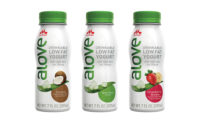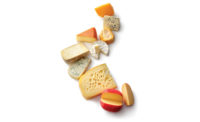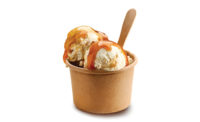2018 State of the Industry report: A healthy slam-dunk for butter
Butter continues its comeback as fans realize its benefits




Team Butter has been empowered by recent health studies about its benefits to set a pick on its margarine opponent and drive for the hoop. In the 52 weeks ending Aug. 12, 2018, dollar sales for butter jumped 5.8%, while unit sales rose 1.8%, Chicago-based market research firm IRI reported.
Consumers used to think that low-fat diets and margarine were better for their health, but recent research has shown that natural sources of fat, including butter, are beneficial, explained Venae Watts, fifth-generation owner of Minerva Dairy in Minerva, Ohio. She points out that popular diets, including the keto diet, encourage daily intake of fatty foods, including butter, for healthy, natural fuel.
Butter’s long-term zone defense strategy has started to pay off.
Milk | Cheese | Cultured | Ice Cream | Butter | Non-dairy Beverages | Ingredients | Exports
“We’ve always stood by butter being a healthy fat, especially when compared with margarine and artificially manufactured spreads,” said Tim Anderson, senior vice president of foodservice and retail for Challenge Dairy Products Inc., Dublin, Calif. “Challenge Dairy hasn’t adjusted its formula because consumers are now wise. It’s not needed.”
Because of this shift, household penetration of butter has climbed to nearly 80%, according to global market research firm Mintel. Furthermore, per-capita butter consumption has climbed to nearly 6 pounds per person per year — its highest point in almost 40 years, noted Doug Glade, executive vice president of commercial operations for Dairy Farmers of America (DFA), Kansas City, Kan.
A clean team
Butter offers consumers more than just fat content, though. Many products are natural and boast clean labels and free-from claims. For example, Epicurean Butter, Denver, offers recombinant bovine somatotropin (rBST)-free butter. Cows that are given rBST to increase milk production often need increased antibiotics, which could potentially result in negative side effects for dairy product consumers.
Consumers also are interested in organic products. Following the successful launch of its organic dairy products line last year, Westby, Wis.-based Westby Cooperative Creamery added an organic butter product to its portfolio under its Westby Organic brand. The new sweet cream product is lightly salted with Celtic sea salt and contains 85% butterfat, which makes it suitable for cooking and baking, the company said.
Home-court advantage
As consumers spend more time in their own kitchens preparing food, they also are showing an interest in food products that are sourced close to home. This has prompted a consumer shift toward butter because people associate it with local and regional dairies, while they associate margarines with big multinational food companies, DFA’s Glade explained.
Minerva Dairy embraces the local trend. The nearly 125-year-old creamery long has sourced its cream from local family-owned farms with pasture-raised cows.
“This type of wholesomeness results in not only a great-tasting end product, but a trustworthy brand that consumers relate to,” Watts said.
Calling out this feature on packaging could be a key tactic for encouraging consumer trial. Although many consumers tend to stick to one particular brand of butter, a third of butter, margarine and oil consumers Mintel surveyed said they would be interested in trying locally made products.
The taste of victory
Consumers seek out many label claims for their butter products, but their top consideration often is taste, Watts said.
“Consumers are looking first and foremost for a rich, delicious taste and texture in butter,” she explained.
New butter product releases are making it easier for consumers to add this taste and texture profile to their foods. Challenge Dairy Products introduced spreadable butter with virgin coconut oil under its Danish Creamy brand. The brand chose to incorporate coconut oil to not only create a spreadable texture, but also infuse the product with the superfood benefits of coconut oil. This can help consumers meet both their health and convenience needs, the company said.
Taking this convenience trend even further, Arden Hills, Minn.-based Land O’Lakes Inc. released Land O Lakes Soft Squeeze butter spread, a spreadable butter packaged in a squeezable bottle that allows consumers to easily add butter to corn on the cob, pancake batter or eggs, said Catherine Fox, senior marketing director, retail butter and spreads.
Beyond the basic butters, consumers also are interested in flavored butters. Watts attributes this interest to the current foodie culture, as well as to restaurants introducing premium flavored butters. Minerva Dairy launched a small-batch Maplewood smoked butter in 2017. To produce the limited-time product, Minerva Dairy cold smokes its 84% butterfat butter with Maplewood chips. And two years ago, Land O’Lakes launched a seasonal pumpkin pie spice butter spread, which made a return to shelves this fall.
Championship strategies
Now that butter has a high household penetration, the key to category growth will be to increase the number of usage occasions and to encourage consumers to try other products. Epicurean is executing a full-court press on this initiative. The company said it created 1-ounce packets of its flavored butters for meal kits for flavoring vegetables, meats, pasta and more. The brand also has been partnering with grocery retailers to include the flavored butter packets with packages of fresh vegetables for consumers to garnish their food at home.
DFA’s Glade suggested that other butter brands should consider offering smaller packaging sizes to encourage consumers to try new brands and flavors and to keep unit prices down. Because of its premium nature, butter commands a higher price than margarine. Although consumers often are willing to spend the extra amount for butter’s health attributes, Mintel cautions that if prices continue to rise, they might have to revert back to margarine to stay within their budgets.
For now, though, Mintel predicts that the butter, margarine and oils category will continue to grow by 6% through 2022.
“It’s a pretty exciting time to be in the better butter business,” Watts pointed out.
Milk | Cheese | Cultured | Ice Cream | Butter | Non-dairy Beverages | Ingredients | Exports
Looking for a reprint of this article?
From high-res PDFs to custom plaques, order your copy today!







